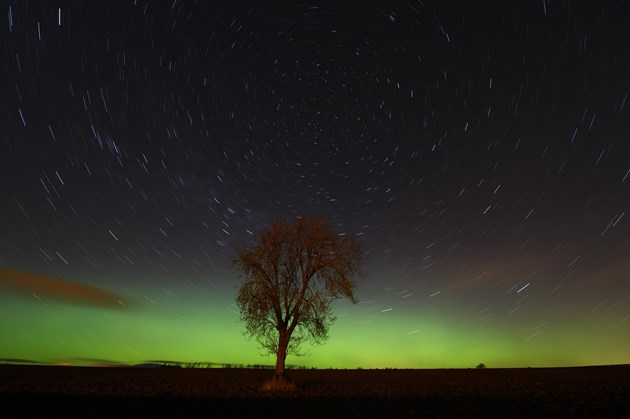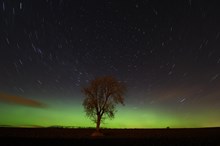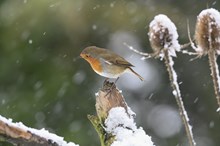21 December, 2022
Acclaimed Gaelic specialist celebrates winter solstice and nature

As Scotland marks its longest night and shortest day – the Winter Solstice – acclaimed Gaelic writer, broadcaster and storyteller Roddy (Ruairidh) Maclean has compiled a unique Gaelic compendium for NatureScot which celebrates the nature, land and heritage of Scotland in the winter season.
From the evocative Night of the Seven Suppers (Oidhche nan Seachd Suipearan), through the cosmic spectacle of the Ursids meteor shower (An Dreagbhod) and on to January’s Wolf Month (Am Faoilleach), the connections between Gaels and the natural world echo out from each turn of phrase and depiction.
In presenting the Winter Solstice Gaelic Compendium for NatureScot, below, Roddy Maclean said: “As keepers of a unique language and culture, the love Gaels have for their native environment resonates in these markers of winter. It has been a joy to compile them to celebrate the Winter Solstice of 2022.
“Language and its deep relations with nature help us experience a greater love and respect for our environment, where Gaelic can be at the heart of a holistic conservation movement to cope with climate change, species extinction and loss of biodiversity.”
Robyn Ireland, NatureScot’s Gaelic Officer, said: “We are grateful to Roddy Maclean for his work on highlighting the rich and abiding connections between Gaelic and Scotland’s nature. We hope everyone will enjoy a taste of a Gaelic winter solstice.”
Winter Solstice Gaelic Compendium
1. Winter Solstice: Oidhche nan Seachd Suipearan (The Night of the Seven Suppers)
The 21st of December is the longest night and shortest day of the year. It is so named because it can feel – for good or for bad – like a night so long that you could sit down to supper seven times before the sun rises again.
2. Ursa Minor: An Dreagbhod (Meteor constellation)
The unusual annual cosmic phenomenon of the Ursids meteor shower is remembered in the Gaelic name for one of the best-known constellations, which is readily visible at this time of year. The star cluster in question is Ursa Minor (Little Bear), also known as the Little Dipper, which appears almost as an adjacent but reversed mirror image of an even more famous grouping – The Plough, known as Crann-arain (Baker's Shovel) in Gaelic.
The Gaelic name for Ursa Minor is An Dreagbhod, derived from dreag ‘meteor’ and bad ‘constellation’. An Dreagbhod was an important constellation to recognise, particularly for mariners. At its outer end is Polaris, the Pole Star, known in Gaelic as An Reul-iùil (the Guiding Star), because of its usefulness to navigators. It hardly moves through the night or year, and always indicates north.
This year, it is expected that the Ursids will be active on 17-24 December and that they will peak on 22-23 December. To find them, locate the Pole Star which sits above the North Pole.
3. Snow: Sneachd (approximately SHNEH-Uchk)
The best-known place name containing the element sneachd is Coire an t-Sneachda (the Corrie of the Snow) - approximately kor(-uh) un TRE-uchk-uh - in the northern corries of the Cairngorms. The corrie is well-named as, being north facing and relatively sheltered, it holds its snow for a long time.
4. Snow wreath: In addition to sneachd in our placenames, there is also the occasional cuithe (snow wreath). This denotes a place where snow continues to lie when it has melted all around. Two clear examples – both Cuithe Chrom(crooked snow wreath) – are on Cairn Gorm and Lochnagar, the former rarely being shown on maps. The date of the breaking or complete melting of a cuithecould be used to predict the weather for the remainder of the summer and the likelihood of a favourable harvest.
5. Snowflakes: One of the nicest Gaelic words for snow has no direct equivalent in English. It is generally applicable only in very cold weather, when spiandagan(a few snowflakes floating in the wind) are to be seen. If snow is falling very lightly and sparsely, in Gaelic it is ‘tha e a’ spianadh an t-sneachda’.
6. Avalanche: Whereas English adopted the French word avalanche, there is a native Gaelic word for the same phenomenon – maoim-sneachda (gushing forth of snow) – reflecting the fact that avalanches have always been part of life in the Scottish mountains.
7. January: Am Faoilleach (Wolf Month)
The Gaelic calendar is strongly linked to both the Scottish environment and our Celtic heritage. January is Am Faoilleach (approximately ‘um FOEUIL yuch’). This is the Wolf Month, when these wild animals were reputedly at their most dangerous because of hunger.
8. February: Latha Fèill Brìde(Bride’s Feast Day)
The beginning of February is a special time in the Gaelic calendar. It is connected to the ancient pagan figure Brìde and her later Christian namesake. Latha Fèill Brìde (Bride’s Feast Day), the 1st of February, halves the six month interval between the pivotal Celtic celebrations of Samhain (the start of winter) and Bealltainn (the start of summer). People would hope for bad weather at this time, believing that if the 1st of February was a clear, sunny day, the remainder of the winter would likely be long.
9. Redwing: Smeòrach an t-sneachda (Snow thrush)
A Gaelic name for the redwing – smeòrach an t-sneachda (snow thrush) – indicates how this visitor is seen as heralding the winter cold.
10. Robin: Brù-dhearg (‘broo YER-ek’)
The brù-dhearg (robin) was listened to carefully by Gaels as its call was seen to foretell good or bad weather. When it sits in a hedge or bush, giving a subdued chirp, this is viewed as a sure sign of poor conditions to come, whereas when it sings ‘cheerfully’ on a pleasant evening, even if it is overcast, a good day is certain to follow.
11. Mistletoe: Uil-ìoc (All-heal)
The Roman writer Pliny recorded that the ancient Celts regarded mistletoe as the all-healing plant (omnia sanantem). This heritage is retained in the plant’s modern Gaelic name uil-ìoc ‘all-heal’.
12. Black: Dubh (‘doo’)
This is an ideal time of year to analyse place names that contain the Gaelic adjective dubh. While it primarily means ‘black’, in landscape terms it can often mean ‘dark’. The low sun in winter can reveal places that remain in shadow for much of the time and which therefore attract this descriptor. A classic example is the Gleann Dubh (dark glen) south-west of Killin. It opens into Glen Dochart in the north – a direction from which the sun never shines in the winter months – but is surrounded at all other compass points by a ring of great hills which leave it in shade for long periods.
Winter proverbs
13. No wind ever blew that did not fill someone’s sails
Cha do shèid gaoth riamh nach robh an seòl cuideigin
There is a Gaelic proverb cha do shèid gaoth riamh nach robh an seòl cuideigin (no wind ever blew that did not fill someone’s sails), but in the array of Gaelic expressions concerning the wind, it is one of a minority that present a positive outlook. Most concern the challenges of living in such a windy and changeable climate as Scotland boasts!
14. The seagulls of our own shore
Faoileagan a’ chladaich againn fhèin
It might be said of people who belong to our own community and are unlikely to venture far from home that they are faoileagan a’ chladaich againn fhèin (the seagulls of our own shore). If they persist in staying in a poor situation, when they should really move on to better things, they might be termed faoileagan an droch chladaich (seagulls of the bad shore). These sayings arise from the traditional observation that gulls are not as strongly migratory as some other species of seabird – or, at least, many of them can still be seen locally during the winter months.
More information about NatureScot’s work to promote and develop Gaelic can be found on our website.
Ends.
Contact information
- Name
- NatureScot Media
- Telephone
- 0131 316 2655
- media@nature.scot
NatureScot is Scotland's nature agency. We work to enhance our natural environment in Scotland and inspire everyone to care more about it. Our priority is a nature-rich future for Scotland and an effective response to the climate emergency. For more information, visit our website at www.nature.scot or follow us on X at https://x.com/NatureScot
’S e NatureScot buidheann nàdair na h-Alba. Bidh sinn a’ neartachadh àrainneachd na h-Alba agus a’ brosnachadh dhaoine gu barrachd suim a chur ann an nàdar. Tha e mar phrìomhachas againn gum bi nàdar na h-Alba beairteach agus gun dèilig sinn gu h-èifeachdach le èiginn na gnàth-shìde. Tha an tuilleadh fiosrachaidh aig www.nature.scot no air X aig https://x.com/NatureScot






